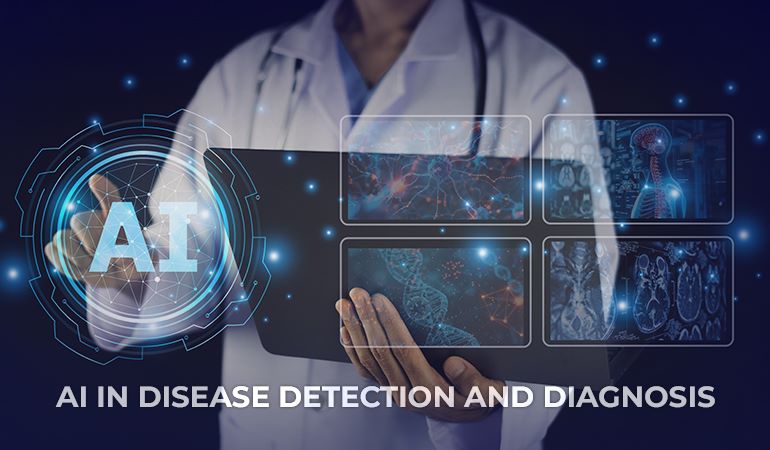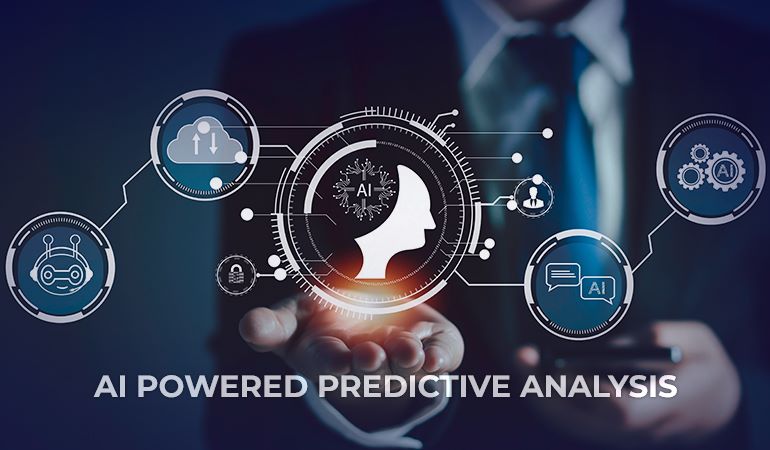Artificial Intelligence (AI) is revolutionizing healthcare systems worldwide, transforming the way we diagnose and treat diseases.
AI mimics human learning behavior by detecting patterns and through image identification. Researchers are working to utilize AI for disease identification and diagnosis. These AI models can be as big of a milestone in medical sciences as penicillin was.
The use of machine learning solutions in healthcare is profoundly altering how medical data is gathered, analyzed, and further developed for improving patient outcomes.
This article explains how AI in disease detection and diagnosis helps us save lives, cut costs, and improve healthcare systems.
Understanding AI in Disease Detection and Diagnosis
Digitization of healthcare systems is picking up pace as hospitals, clinics, and doctors utilize emerging digital health technologies like nanotechnology, robotics, 3D printing, etc.
Adopting these technologies helps you reduce the margin for human error, improve patient and clinical outcomes, enable drug discovery, and track vast amounts of patient data over time.

When you talk about using AI for disease identification, diagnosis, and treatment, you’re explicitly referring to machine learning and deep learning algorithms that enable you to process large data sets to develop diagnostic and treatment plans.
This data includes imaging, lab reports, medical records, and more. Machine learning algorithms identify patterns and anomalies in the data to predict disease onset and prepare diagnostic and treatment plans.
You can use AI to identify environmental, geographic, and demographic areas with high disease frequency or high-risk behaviors.
However, you first need to know how to apply various statistical and machine-learning techniques to understand the way artificial intelligence helps improve disease prediction, diagnosis, and treatment. Here are some of the techniques you should know about.
- Boltzmann machine
- K nearest neighbor (KNN)
- Decision Tree
- Naïve Bayes
- Random Forest
- Ada Boost
- K-Mean clustering
- Recurrent neural networks (RNN)
- Support vector machine (SVM)
- Convolutional neural networks (CNN)
- Deep-CNN
- Long short-term memory (LSTM)
- Generative Adversarial Networks (GAN)
The list goes on, but we have mentioned some of the most popular and valuable techniques AI/ML engineers use to develop advanced algorithms for predicting disease onset and improving diagnosis and treatment.
Applications of AI in Disease Detection and Diagnosis
Here are some of the major applications of AI for disease identification, diagnosis, and treatment:
- Medical Imaging Analysis is used to detect diseases like cancer, fractures, and brain abnormalities through X-rays, MRIs, and CT scans.
- Pathology Detection identifies cancerous cells or tissues in pathology slides.
- Genome Medicine uses AI to analyze genetic data to predict hereditary conditions.
- Rare Disease Diagnosis uses AI to analyze large datasets to identify rare conditions.
- Speech and Language Disorders use AI-powered solutions for issues like aphasia or dysarthria.
Advantages of AI in Healthcare
AI, for now, is mainly used in diagnostic specialties. However, the advantages of AI in healthcare go beyond AI disease detection.
-
Population Health Management
Population health management uses predictive analytics to identify and guide health initiatives. Predictive analytics involves using AI algorithms to study and analyze patient information and predict the chances of specific health outcomes.
You need to train these algorithms on population-representative information to predict a person’s likelihood of developing a particular disease.
In turn, doctors and caregivers can use this information to create specific and customized preventive plans for patients.

Predictive analytics in public health management demand high-quality data and technological infrastructure. AI improves health tech solutions by providing more accurate and efficient predictive models in population health management.
-
Image Analysis
AI analyzes medical images like X-rays, MRIs, and CT scans much more accurately than humans to identify abnormalities that help you predict health outcomes.
You can train machine learning algorithms to detect tumors (benign and malignant), skin disease, Alzheimer’s, liver and coronary disease, blood clots, and other anomalies in medical images.
-
Diagnosis Support
AI also enables high-quality diagnosis support by analyzing patient data to provide accurate diagnoses. AI disease diagnosis suggests a range of possible diagnoses to help doctors detect disease early on and make informed decisions about patient treatment plans.
-
Personalized Treatment
Doctors are using AI to develop personalized treatment and rehabilitation plans for patients. Machine learning analyzes patient data in-depth to provide specific insights to doctors, helping them develop tailored plans to address individual patient needs.
This enables doctors and patients to avoid less-than-optimal treatment and rehab plans, significantly reducing time and costs.
-
Drug Discovery and Development
AI is being used in different parts of drug discovery, such as:
- Drug Design
- Chemical Synthesis
- Drug Screening
- Drug Repurposing
AI analyzes vast datasets to identify potential drug candidates. It can also modify existing medications for new treatments. AI also enables the development of personalized medicine by tailoring treatments based on individual genetic and biological profiles.
-
AI Mental Health Support
AI-powered applications provide digital mental health tools for diagnosing and treating conditions such as depression and substance use disorder. With the best EHR for psychiatry improving data management and treatment workflows.
Mental health professionals require direct interaction with patients to observe their behavior. AI supplements their work through digital mental health tools.
-
Surgical Assistance
AI is poised to revolutionize surgery. It is enhancing surgical assistance and safety in various ways, such as:
- Robotic-Assisted Surgery
- Preoperative Planning
- Automating Surgical Tasks
- Postoperative Monitoring
- Training and Simulation
Benefits of AI in Disease Detection and Diagnosis
AI adoption offers immense breakthroughs in healthcare systems. It gives accurate disease diagnosis and effective treatment plans.
Here are some of the leading benefits of using AI for disease identification, diagnosis, and treatment.
- Improved Accuracy: Artificial intelligence has the potential to analyze huge amounts of patient and clinical information. On the other hand, humans cannot interpret the same amount of data as accurately as AI-based algorithms. Therefore, using AI helps improve the accuracy of diagnosis and enables improved healthcare outcomes.
- Personalized Treatment: AI enables doctors to develop customized treatments, replacing a one-size-fits-all approach. This leads to improved health outcomes as each individual and their disease detection, prevention, and progression varies.
- Efficiency: Another key benefit of using AI in diagnosis and treatment is that it helps improve efficiency by automating repetitive tasks. It can automate patient triad, patient data management, patient triage, etc., thereby adding efficiency to the healthcare system.
- Early Disease Detection: Early disease detection is another critical benefit of AI in healthcare. By detecting the onset of terminal diseases like lung cancer and skin cancer early on, AI helps doctors save lives and reduce the overall cost of illness to society. It also reduces the risk of complications and adverse treatment reactions.
- Accurate Results: Advanced AI tools are improving medical diagnosis by making it more accurate and less prone to errors. They help doctors analyze medical tests quickly, reducing false positives and negatives to ensure more reliable results. This assists healthcare providers in making better decisions, leading to more effective and personalized care for patients.
However, there are also challenges involved in using AI in healthcare. Let’s look at some of these challenges.
Challenges of Using AI in Diagnosis and Treatment
Widespread AI adoption for healthcare-related goals poses some challenges. Some of these are listed below.
- Data Quality: How well AI helps improve disease diagnosis and treatment depends on the data you feed its machine learning algorithms. If you feed inaccurate data, the results will also be false.
- Bias: It is possible for AI algorithms to be biased if you feed biased data into them. These biases are then reflected in poor treatment plan suggestions and inaccurate diagnoses.
- Regulatory Issues: Patient consent and data privacy are leading concerns plaguing the image of AI solutions. Many people, including patients, worry about the privacy of their data and sensitive information. AI also raises ethical concerns regarding data privacy and its possible use for nefarious purposes.
- Cost: Although AI promises cost reductions in the long term, developing, managing, and implementing AI systems requires a significant investment, thus limiting its adoption.
- Ethical Issues: It is important to ensure that AI-based guidelines are transparent, fair, and informed by patient privacy and ethical considerations.
Conclusion
The use of artificial intelligence is rapidly growing as one industry after another adopts it to increase efficiency, enable automation, innovate new products and services, and solve problems. The healthcare industry is no different.
In fact, it is in the healthcare industry that AI tools and platforms are showing promising results. Although using AI in disease detection and diagnosis offers many benefits, it also presents some challenges.
However, just because an emerging technology comes with challenges does not mean one should not adopt it. Instead, we should try to overcome these challenges, which is something machine learning is designed to do itself.
The use of AI in healthcare is expected to grow further as new realms of medical science coalesce with digital technologies to improve healthcare systems worldwide. From automated scheduling to homecare AI-powered robots, AI is and continues to revolutionize healthcare systems.
Xavor is a leading technology company working on building a homecare robot companion that facilitates patient recovery after total hip and knee replacement surgery.
Contact us at [email protected] to learn more about how Xavor is contributing to the healthcare industry’s evolution by employing advanced machine learning algorithms.

